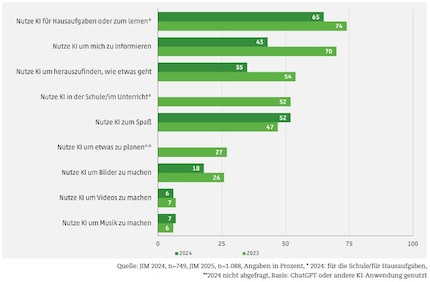
News + Trends
The largest ChatGPT study shows: This is how we really use AI
by Luca Fontana

AI tools are increasingly conquering people's everyday lives. Young people are not exempt from this. A representative study shows that 91 percent of young people between the ages of twelve and 19 use AI.
More and more young people in Germany are using AI tools for schoolwork. While 65 percent still used AI chatbots for learning and homework in 2024, this year it is already 74 percent. This is one of the findings of the JIM Study 2025, a representative survey on the media use of young people between the ages of twelve and 19.
According to the study, 70 percent of the 1200 respondents also use AI for general information search. This means that AI tools are now in second place behind classic search engines such as Google. The figure has risen sharply within a year: in 2024, the proportion was still 43 percent - and 57 percent of young people consider the AI-generated results to be trustworthy.
The results of the JIM study show that learning processes are undergoing major change, which educational institutions must respond. This also includes the teaching of skills for recognizing false information.
91 percent of the young people surveyed say they use at least one AI application. This is a strong increase compared to the previous year, when this figure was still 62 percent. ChatGPT is by far the most popular tool: 84 percent have already used the chatbot, which is an increase of 27 percent compared to 2024. Half of the kids use it several times a week.
Young people use AI mainly for learning and for the general search for information. 54 percent say they ask AI to show them how to do something. While more than half of those surveyed (52 percent) still used AI for entertainment last year, this motive is the only one that has lost importance at 47 percent. Far behind are creative uses, i.e. AI for creating images, videos and music.

In addition, it was found that younger people tend to use AI for pleasure, while older people focus on knowledge-oriented purposes. This difference is also evident in the educational background: In higher schools, young people use AI more often as a learning aid and for research and less for fun.
Around 60 percent of young people believe that AI helps to overcome social challenges – for example in the areas of climate, mobility and medicine. The statement "The information from AI can be trusted" is also agreed with by almost 60 percent across all age groups.
Young people are aware that AI can generate fake news through generated images and videos. 35 percent say they are good or very good at detecting deepfakes and performing reverse image searches. However, 20 percent are not familiar with the term deepfake – in the youngest age group, this figure is significantly higher at 40 percent.
At the same time, around 60 percent of young people fear that AI will push people out of professions. 37 percent are concerned about AI in general.
However, the study shows differences between the sexes. Girls are more likely than boys to have reservations about AI: 44 percent express concern about AI, compared to only 31 percent of boys. When it comes to tackling societal challenges, 55 percent of female respondents are optimistic about AI. Among men, the figure is 63 percent.
Feels just as comfortable in front of a gaming PC as she does in a hammock in the garden. Likes the Roman Empire, container ships and science fiction books. Focuses mostly on unearthing news stories about IT and smart products.
From the latest iPhone to the return of 80s fashion. The editorial team will help you make sense of it all.
Show all